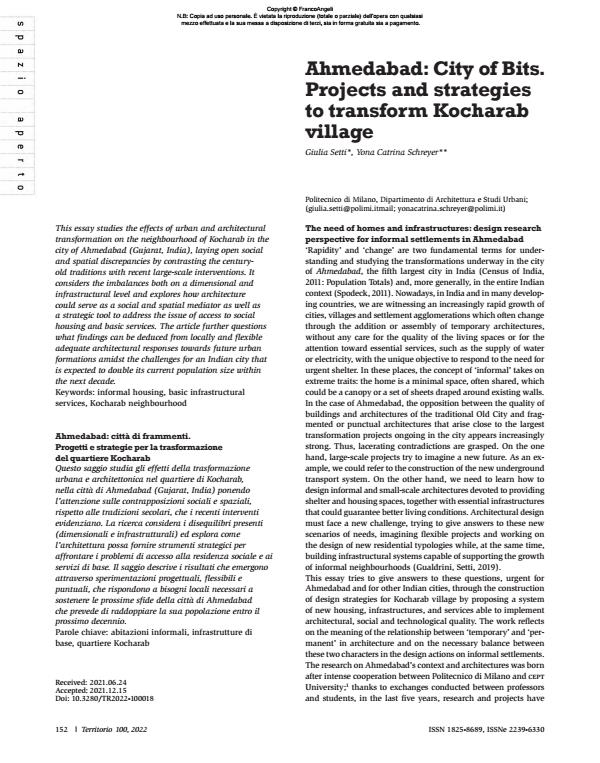Ahmedabad: City of Bits. Projects and strategies to transform Kocharab village
Titolo Rivista TERRITORIO
Autori/Curatori Giulia Setti, Yona Catrina Schreyer
Anno di pubblicazione 2022 Fascicolo 2022/100
Lingua Inglese Numero pagine 12 P. 152-163 Dimensione file 825 KB
DOI 10.3280/TR2022-100018
Il DOI è il codice a barre della proprietà intellettuale: per saperne di più
clicca qui
Qui sotto puoi vedere in anteprima la prima pagina di questo articolo.
Se questo articolo ti interessa, lo puoi acquistare (e scaricare in formato pdf) seguendo le facili indicazioni per acquistare il download credit. Acquista Download Credits per scaricare questo Articolo in formato PDF

FrancoAngeli è membro della Publishers International Linking Association, Inc (PILA)associazione indipendente e non profit per facilitare (attraverso i servizi tecnologici implementati da CrossRef.org) l’accesso degli studiosi ai contenuti digitali nelle pubblicazioni professionali e scientifiche
This essay studies the effects of urban and architectural transformation on the neighbourhood of Kocharab in the city of Ahmedabad (Gujarat, India), laying open social and spatial discrepancies by contrasting the century- old traditions with recent large-scale interventions. It considers the imbalances both on a dimensional and infrastructural level and explores how architecture could serve as a social and spatial mediator as well as a strategic tool to address the issue of access to social housing and basic services. The article further questions what findings can be deduced from locally and flexible adequate architectural responses towards future urban formations amidst the challenges for an Indian city that is expected to double its current population size within the next decade.
Questo saggio studia gli effetti della trasformazione urbana e architettonica nel quartiere di Kocharab, nella città di Ahmedabad (Gujarat, India) ponendo l’attenzione sulle contrapposizioni sociali e spaziali, rispetto alle tradizioni secolari, che i recenti interventi evidenziano. La ricerca considera i disequilibri presenti (dimensionali e infrastrutturali) ed esplora come l’architettura possa fornire strumenti strategici per affrontare i problemi di accesso alla residenza sociale e ai servizi di base. Il saggio descrive i risultati che emergono attraverso sperimentazioni progettuali, flessibili e puntuali, che rispondono a bisogni locali necessari a sostenere le prossime sfide della città di Ahmedabad che prevede di raddoppiare la sua popolazione entro il prossimo decennio.
Keywords:abitazioni informali, infrastrutture di base, quartiere Kocharab
- cept Archive, 1969, Bhadra and Ahmedabad Growth, cept University: Ahmedabad. https://cept.ac.in/search.php?search=1969%2C+Bha-dra+and+Ahmedabad+Growth%2C (access: 2021.02.15).
- Correa C., 2012, A Place in the Sun - The New Landscape and Other Essays. Ostfildern: Hatje Cantz Publishers.
- Doshi B., 2011, Paths Uncharted. Ahmedabad: Vastu Shilpa Foundation for Studies and Research in Environmental Design.
- Doshi H. 1991, «Traditional Neighborhood in Modern Ahmedabad: The Pol». In: Rao M., Bhat C., Kadekar L. (eds.), A Reader in Urban Sociol- ogy. New Delhi: Orient Longman Limited.
- Environmental Planning Collaborative 1998, Sabarmati Riverfront Devel- opment Project Feasibility Report, Paritosh Usmanpura: Ahmedabad. -- https://sabarmatiriverfront.com/wp-content/uploads/2020/07/srfd-fe- asibility-report-epc.pdf (access: 2019.04.28).
- Fanelsa N., Helten M., Martenson B., Wertgen L., 2015, Ahmedabad Architecture Reading Aid. Berlin: Ruby Press.
- Gillion K.L., 1968, Ahmedabad: A Study in Indian Urban History. Berkeley and Los Angeles: University of California Press.
- Gualdrini G., Setti G., 2019, «Ahmedabad: identità urbana divisa. Strategie progettuali in ‘confini contesi’». Territorio, 90: 131-140. DOI: 10.3280/TR2019-090015
- Lambel N., Dongre A., 2016, Analysing Social Relevance of Spatial Organisation: A Case Study of Traditional Pol Houses, Ahmedabad, India. Nagpur: Canadian Center of Science and Education.
- Lerner M., 1984, The Flame and the Lotus: Indian and Southeast Asian Art from the Kronos Collections. New York: Metropolitan Museum of Art.
- Nanda V., 1991, «Urbanism, Tradition, and Continuity in Ahmedabad». In: Khan H.U. (ed.), Mimar: Architecture in Development, 38. London: Concept Media Ltd.
- Office of the Registrar General & Census Commissioner India, 2011, Census of India – Population Totals. Delhi: Ministry of Home Affairs. -- https:// censusindia.gov.in (access: 2019.07.12).
- Oxford Economics, 2018, Global Cities 2035 - The Future of the World’s Leading Urban Economies to 2035. Oxford: Oxford Economics.
- Rossi A., 1982, The Architecture of The City. Boston: The mit Press. Rössl S. 2018, Housing in India. Charles Correa, Balkrishna Vithaldas Doshi, Raj Rewal. Macerata: Quodlibet.
- Sharma N., 1995, Role of Rituals in the Transformation of a City and is Urban Components. A Study of Ahmedabad, is Urban Components Maidan-I-Shadi and Manek Chowk. Manhattan (Kansas): Kansas University. https://core.ac.uk/download/pdf/84601047.pdf (access: 2021.04.01).
- Spodeck H., 2011, Ahmedabad: Shock City of Twentieth-Century India. Bloomington: Indiana University Press.
- unesco, 2017, World Heritage Report 2017. -- http://whc.unesco.org/en/ list/1551 (access: 2019.03.15).
Giulia Setti, Yona Catrina Schreyer, Ahmedabad: City of Bits. Projects and strategies to transform Kocharab village in "TERRITORIO" 100/2022, pp 152-163, DOI: 10.3280/TR2022-100018